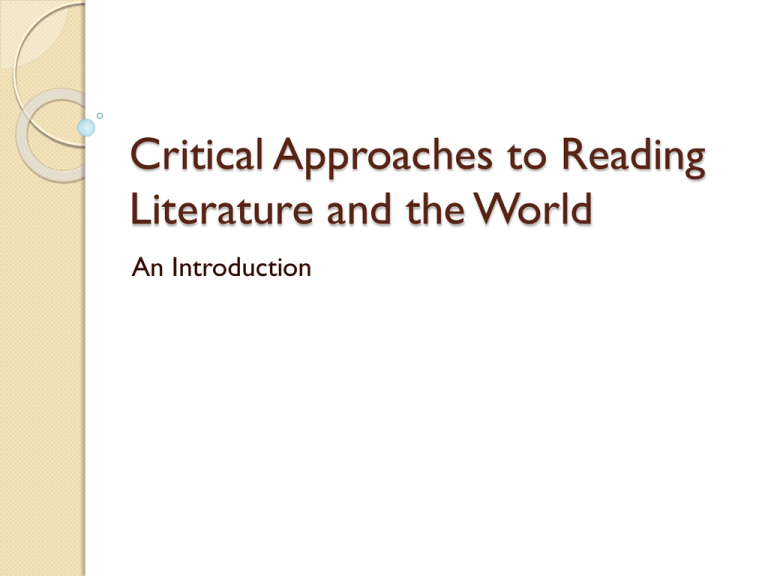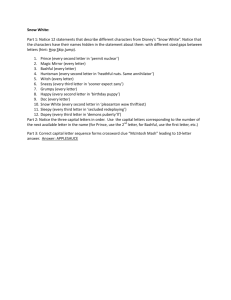
Critical Approaches to Reading
Literature and the World
An Introduction
New Criticism
A reaction against too much focus on author
New Critics focus on the text itself
Every element of a text– language, structure,
setting, characterization, point of view, etc.–
works to support its overarching meaning.
The way a text is written—its style or
organization—reveals the meaning of the text.
What stands out through the New
Critical lens:
Character of queen, who will
stop at nothing to be the “fairest
in the land.”
“envy and pride grew like weeks
in her heart, until she knew no
peace by day or by night.”
“she was forced to step into the
red-hot shoes and dance till she
fell to the floor dead.”
A New Critical reading of “Snow
White” suggests that…
Envy corrupts the soul
Evil may persist, but will
eventually extinguish itself
New Critical Reading of “Snow White”
Feminist Criticism
Gender affects the way we read and write
literature
Most literature in Western tradition was
written by men and for men, with a male
view of the world.
Differences between men and women
should be valued.
Society sets up roles for each gender that
appear in literature. (gender stereotypes)
Let’s try a feminist reading of “Snow
White”…
What stands out through the Feminist
lens:
How a feminist would read “Snow
White”
Snow white happily keeps house for
the dwarves:
According to Karen Rowe, fairy tales such
as “Snow White”…
“ ‘If you do the cooking and make
the beds and wash and sew and knit,
and keep everything neat and clean,
you can stay with us’… ‘Oh yes,’ said
Snow White. ‘I’d love to.’”
“perpetuate the patriarchal status quo
by making female subordination seem
a romantically desirable, indeed
inescapable fate” (Hallett & Karasek
344).
Snow White is helpless until rescued
by prince
Queen is punished for her ambition
and cunning, manipulative skill
Encourage passivity, domesticity, and
dependency on men, and discourage
cleverness, willpower, and independent
thinking
Suggest marriage as ultimate (and only)
ideal happiness for a woman.
Feminist Reading of “Snow White”
Psychoanalytic Criticism
Applies Freudian theory (id/ego/superego) to
the text’s author, characters, and readers’ minds
People’s hidden desires or fears may surface
through dreams, actions, or writing
◦ characters’ actions/motivations fueled by unconscious
desires and fears
Characters symbolize different aspects of
human psyche
What stands out through the
psychoanalytic lens:
Queen’s jealousy of Snow
White’s beauty?
Snow white’s repressed
sexual desires? (attraction
to “forbidden” objects:
comb, corset, apple)
A psychoanalytic reading of “Snow
White” suggests that…
Competition for father
figure (King)- Oedipal
complex?
In the journey to sexual
awakening, a young woman
is inevitably presented with
dangers and temptations of
the world, no matter how
protected she is. It takes
the proverbial “death” of
innocence for her to arrive
at adulthood.
Psychoanalytic reading of “Snow White”
Archetypal Criticism
Attempts to identify patterns, narrative designs,
characters, and images that evoke deep universal
responses in readers.
Based on Carl Jung’s theory that humanity has
developed archetypes-- a “collective
unconscious”—or a universal collection of
experiences and memories embedded in the
minds of all men and women.
Archetypal critics look for these patterns in art,
mythology, literature, and dreams.
SOME EXAMPLES OF ARCHETYPES
Death and rebirth
The hero’s journey
The heavenly ascent
The search for the father
the Promethean rebel-hero,
The earth goddess or earth mother
The femme fatal or temptress
The damsel in distress
New Historicist Criticism
A reaction to New Criticism: a text can’t be
read as a whole in and of itself; author and
context are important.
Historical context is important, but “history” is
not objective.
◦ What is the value of reading a novel such as Night to
understand the Holocaust?
Our understanding of history is shaped by who
we are and our own time period.
Cultural Studies Criticism
Texts, writers, and readers are embedded in
cultural contexts that frame their creation and
interpretation.
To understand the meaning of a text, a reader must
understand the cultural background(s) of the
characters, the cultural setting of the text, and
social contexts in which the text was written,
produced, and read.
Examines how a text represents of groups of
people who have been historically oppressed
because of their race or cultural difference (e.g. the
impact of colonialism on minority groups).
Deconstruction Criticism
There is always more than one way to see an
issue or idea
A text often contains opposite ideas that both
contradict each other and work together at
the same time (e.g. love vs. hate, fate vs. free
will, good vs. evil).
Things cannot be categorized as “black” or
“white”— it’s necessary to explore the “grey”
areas.
It’s necessary to challenge ideas we take for
granted as “true.”
Reading Hesiod’s Theogony (p.6367)with the Critical Approaches…
Take notes on the following:
When you look at the text through the
_________ lens, what stands out? What can
you see through this lens that you didn’t
notice before?(Characters, conflicts, images,
etc.)
Through this lens, what does the text seem
to be about? (Consider the text’s overall
attitudes or themes).








